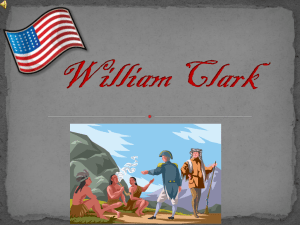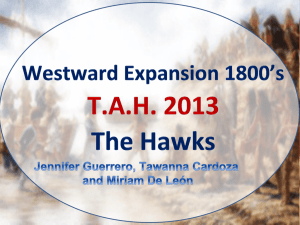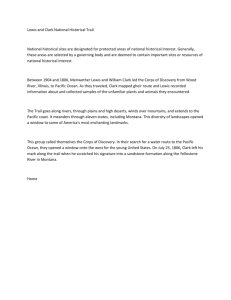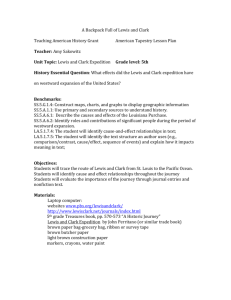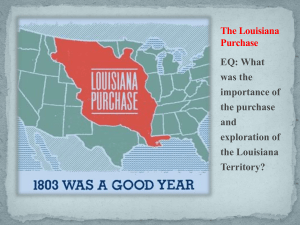Attachment D - Ohio Department of Education
advertisement
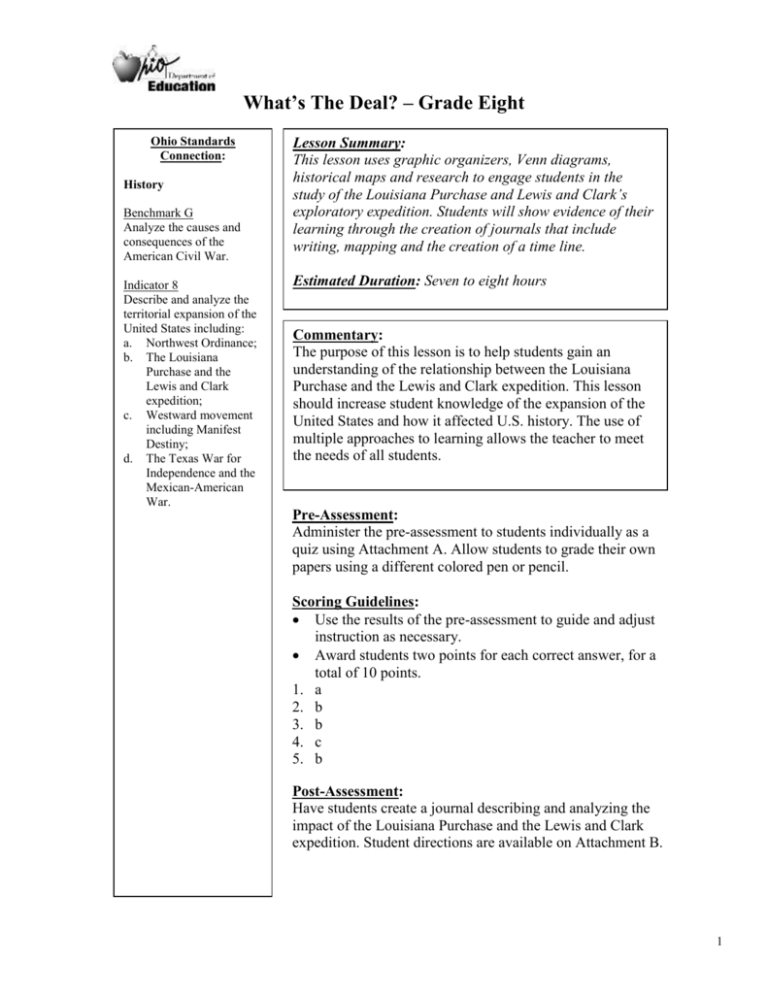
What’s The Deal? – Grade Eight Ohio Standards Connection: History Benchmark G Analyze the causes and consequences of the American Civil War. Indicator 8 Describe and analyze the territorial expansion of the United States including: a. Northwest Ordinance; b. The Louisiana Purchase and the Lewis and Clark expedition; c. Westward movement including Manifest Destiny; d. The Texas War for Independence and the Mexican-American War. Lesson Summary: This lesson uses graphic organizers, Venn diagrams, historical maps and research to engage students in the study of the Louisiana Purchase and Lewis and Clark’s exploratory expedition. Students will show evidence of their learning through the creation of journals that include writing, mapping and the creation of a time line. Estimated Duration: Seven to eight hours Commentary: The purpose of this lesson is to help students gain an understanding of the relationship between the Louisiana Purchase and the Lewis and Clark expedition. This lesson should increase student knowledge of the expansion of the United States and how it affected U.S. history. The use of multiple approaches to learning allows the teacher to meet the needs of all students. Pre-Assessment: Administer the pre-assessment to students individually as a quiz using Attachment A. Allow students to grade their own papers using a different colored pen or pencil. Scoring Guidelines: Use the results of the pre-assessment to guide and adjust instruction as necessary. Award students two points for each correct answer, for a total of 10 points. 1. a 2. b 3. b 4. c 5. b Post-Assessment: Have students create a journal describing and analyzing the impact of the Louisiana Purchase and the Lewis and Clark expedition. Student directions are available on Attachment B. 1 What’s The Deal? – Grade Eight Scoring Guidelines: Use the rubric provided on Attachment C. Instructional Procedures: Day One 1. Conduct the pre-assessment. 2. Use the K-W-L Chart, Attachment D, to guide a follow-up class discussion. Have students record what they Know and what they Want to learn about the Louisiana Purchase and Lewis and Clark. At the end of the lesson, come back to this graphic organizer and have students record what they Learned. Day Two 3. Select a picture book that recounts the story of Lewis and Clark’s expedition. Read half of the book to students. Ask students to write a prediction of how they think the book will end. 4. Have students share their endings to the story. 5. Read the conclusion of the book and discuss the differences between student predictions and actual events. 6. Have students individually complete the Venn Diagrams, Attachment E, comparing their endings to the actual ending of the story. The Venn diagram for this activity should be labeled: My Ending What Both Endings Have in Common Real Ending Day Three 7. Distribute the vocabulary, dates and facts of the Louisiana Purchase and the Lewis and Clark expedition, Attachment F. 8. Have students use textbooks, trade books, encyclopedias and Internet access to answer the Guided Research Questions, Attachment G. Day Four 9. Review the concept of historical maps with students. 10. Focus on historical maps that depict: Land gained by the Louisiana Purchase; The routes taken by Lewis and Clark; The states that were formed from this land. 11. Divide students into pairs. Distribute blank historical maps depicting the U.S. in 1803 and blank U.S. maps depicting the 48 contiguous states. Have students follow the instructions found in Attachment H to assist them in labeling their maps. Day Five 12. Have students conduct research on the impact of the Lewis and Clark expedition on American Indians and American citizens. How were the two groups impacted differently? After the expedition, how did life for American Indians change? How was life for American citizens different? 2 What’s The Deal? – Grade Eight 13. Have students complete a graphic organizer showing the impact of the Louisiana Purchase and Lewis and Clark expedition on American Indians and American Citizens using Attachment I. Allow students to use textbooks, trade books, encyclopedias and Internet access to complete this assignment. Day Six 14. Distribute Attachments B and C for the post-assessment. Discuss the instructions and allow students to ask clarifying questions about the culminating project. 15. Provide students with the following materials to create a journal: construction paper, markers, crayons, notebook paper and brass clips. 16. Have students begin on their covers and journals. Allow students three to five evenings to complete their culminating project at home. 17. Have students complete the K-W-L Chart from Day One with what they have learned. Differentiated Instructional Support: Instruction is differentiated according to learner needs, to help all learners either meet the intent of the specified indicator(s) or, if the indicator is already met, to advance beyond the specified indicator. Have students work independently, in pairs or heterogeneous groups to complete the journal activity. Allow students to choose to complete the journal activity using a variety of modes including visual, auditory, tactile, etc. Challenge students to predict what would have happened if Lewis and Clark had taken an alternative route. Have student(s) create an interactive learning center for the class focusing on Lewis and Clark. Extensions: Have students create a 3-D map based on the study of Lewis and Clark. Brainstorm with students ideas of what goes into a museum exhibit. Challenge students to create replicas of artifacts and items that would be featured in a museum exhibit about Lewis and Clark. Have students compare Pike’s expedition to Lewis and Clark’s. Have students who have traveled in the western part of the country prepare a slide presentation to share with the class. Homework Options and Home Connections: Have students look at the “Want Ads” in a local newspaper and create a poster advertising the need for expedition members to accompany Lewis and Clark. Instruct students to address the following questions: What skills would they need? What kind of people are best suited for this job? Where will they go and for how long? What supplies should they bring? 3 What’s The Deal? – Grade Eight Interdisciplinary Connections: English Language Arts Reading Process Benchmark A: Apply reading comprehension strategies to understand grade-appropriate texts. Indicator 1: Apply reading comprehension strategies, including making predictions, comparing and contrasting, recalling and summarizing and making inferences and drawing conclusions. Research Benchmark B: Evaluate the usefulness and credibility of data and sources. Indicator 2: Identify appropriate sources and gather relevant information from multiple sources (e.g., school library catalogs, online databases, electronic resources and Internet-based resources). Materials and Resources: The inclusion of a specific resource in any lesson formulated by the Ohio Department of Education should not be interpreted as an endorsement of that particular resource, or any of its contents, by the Ohio Department of Education. The Ohio Department of Education does not endorse any particular resource. The Web addresses listed are for a given site’s main page, therefore, it may be necessary to search within that site to find the specific information required for a given lesson. Please note that information published on the Internet changes over time, therefore the links provided may no longer contain the specific information related to a given lesson. Teachers are advised to preview all sites before using them with students. For the teacher: Reference materials for students, picture book based on Lewis and Clark’s expedition, historical outline map of U.S. around 1803, outline map of 48 contiguous United States. For the students: Outline maps, construction paper, markers, colored pencils, crayons, writing paper, graph paper, drawing paper, brass clips. Vocabulary: ambassador artifact botany cache celestial navigation compass conflict contiguous continental divide corps expedition interpreter Louisiana Purchase 4 What’s The Deal? – Grade Eight Missouri Compromise negotiate provisions specimen tributary Technology Connections: Provide students with the opportunity to view portions of documentary videos depicting the Lewis and Clark expedition. Have students create a slide show presentation illustrating the route(s) taken by Lewis and Clark. Research Connections: Marzano, R. et al. Classroom Instruction that Works: Research-Based Strategies for Increasing Student Achievement, Alexandria, VA: Association for Supervision and Curriculum Development, 2001. Nonlinguistic representations help students think about and recall knowledge. This includes the following: Creating graphic organizers; Making physical models; Generating mental pictures; Drawing pictures and pictographs; and Engaging in kinesthetic activity. Ogle, D. Reading Comprehension: Strategies for Independent Learners. Guilford Press, 2001. Ogle, D. Reading Teachers, “K-W-L: A teaching model that develops active reading of expository text,” 1986. Volume 40, p. 564-570. General Tips: Use school and public libraries to supplement classroom resources. Libraries should be able to provide picture books, trade books and videos for student use. If historical outline maps are unavailable, provide students with a physical map of North America and have students draw in the necessary details using a textbook map as an example. Most textbooks should include a map of the Louisiana Purchase and Lewis and Clark’s routes for students to use. Excerpts of Lewis and Clark’s journals can be found in history textbooks, adult history books and online. Because the original journals are lengthy, select passages appropriate for students to read. 5 What’s The Deal? – Grade Eight Attachments: Attachment A, Pre-Assessment Attachment B, Post-Assessment Attachment C, Post-Assessment Rubric Attachment D, K-W-L Chart Attachment E, Venn Diagram Attachment F, Vocabulary and Key Dates Attachment G, Guided Research Questions Attachment H, Historical Map Instructions Attachment I, Graphic Organizer for Perspectives 6 What’s The Deal? – Grade Eight Attachment A Pre-Assessment Directions: Select the appropriate answer to each question. 1. Livingston and Monroe negotiated the purchase of the Louisiana Territory from: a. France c. Spain b. Portugal d. Great Britain 2. As a result of the Louisiana Purchase, the United States: a. Annexed 10 states c. Acquired Alaska b. Doubled in size d. Tripled in size 3. Who was the President of the United States at this time? a. George Washington c. James Monroe b. Thomas Jefferson d. James Madison 4. Who was sent to explore the newly purchased Louisiana Territory? a. Jackson and Calhoun c. Lewis and Clark b. Lincoln and Hamlin d. Wilson and Sherman 5. The purpose of the their expedition was to: a. Find gold b. Map a route to the Pacific Ocean c. Build a city d. Explore the Mississippi River 7 What’s The Deal? – Grade Eight Attachment B Post-Assessment Directions: Create an eight to ten page journal that includes the perspectives of historical figures, maps and a time line. Requirements: 1. At least one page explaining the impact of the Louisiana Purchase and the Lewis and Clark expedition from the perspective of an American citizen and one page explaining the impact from the perspective of an American Indian from one of the tribes Lewis and Clark encountered. (total of two pages/ one page for each perspective) 2. Using an 1803 historical outline map, accurately place four stops Lewis and Clark made together going to the Pacific Ocean. Also, place at least two stops for Lewis and two stops for Clark when they traveled separately on their return trips to Missouri. (one page) 3. Using a United States outline map, identify and label the 13 states developed from the Louisiana Purchase. (one page) 4. Using a United States outline map, correctly label the line drawn as a result of the Missouri Compromise. Shade the slave states blue and the free states red. (one page) 5. Create a time line with at least fifteen relevant facts that took place during the Louisiana Purchase and Lewis and Clark’s expedition. Describe each event in at least one full sentence using the vocabulary words studied. (one page) Sample Table of Contents Page 1 Page 2 Page 3 Page 4 Page 5 Page 6 American Citizen Perspective American Indian Perspective Student Drawn Map of Lewis and Clark Routes U.S. Map of States Formed From Louisiana Purchase U.S. Map of States That Were Admitted as Free or Slave A Time Line With 15 Events This is a general table of contents showing how your journal should be arranged. You are allowed to add up to three more pages of content that will be graded as extra credit. 8 What’s The Deal? – Grade Eight Attachment C Post-Assessment Rubric American Citizen Perspective American Indian Perspective Map of Lewis and Clark Routes Map of Louisiana Purchase Map of Slave and Free States Time Line 4 Uses the proper perspective and accurate details to explain the impact of both events on citizens. Uses the proper perspective and accurate details to explain the impact of both events on American Indians. Accurately labels and illustrates the routes taken by Lewis and Clark. The map includes color and a key. Accurately labels the 13 states formed from the Louisiana Purchase. The map includes color and a key. 3 Uses the proper perspective to accurately explain the impact of both events on citizens. 2 Uses the proper perspective to somewhat explain the impact of both events on citizens. 1 Inaccurately explains the impact of both events on citizens. Uses the proper perspective to accurately explain the impact of both events on American Indians. Accurately labels and illustrates the routes taken by Lewis and Clark. Uses the proper perspective to somewhat explain the impact of both events on American Indians. Attempts to label and illustrate the routes taken by Lewis and Clark. Inaccurately explains the impact of both events on American Indians. Inaccurately labels and illustrates the routes taken by Lewis and Clark. Accurately labels the 13 states formed from the Louisiana Purchase. Attempts to label the 13 states formed from the Louisiana Purchase. Inaccurately labels the 13 states formed from the Louisiana Purchase. Accurately identifies, labels and colors the 36o30’ line and slave and free states. Map includes a key. Time line accurately describes 15 relevant events with full sentences, includes appropriate illustrations and details. Accurately identifies the 36o30’ line and slave and free states. Attempts to identify the 36o30’ line and slave and free states. Inaccurately identifies the 36o30’ line and slave and free states. Time line accurately describes 15 relevant events with full sentences. Time line accurately describes less than 15 relevant events with full sentences. Time line accurately describes less than seven relevant events with full sentences. 9 What’s The Deal? – Grade Eight Attachment D K-W-L Chart Directions: Based on the topic given, list all of the things you already know and the things you would like to learn during this lesson. At the end of your study, complete the last column with information about what you have learned. Topic: _______________________________ What I Know What I Want To Know What I Have Learned 10 My Ending What Both Endings have in Common Attachment E Venn Diagram Real Ending What’s The Deal? – Grade Eight 11 What’s The Deal? – Grade Eight Attachment F Vocabulary and Key Dates Key People 1. Napoleon Bonaparte- leader of France who had the most powerful army in Europe. 2. Jean Baptiste- son born to Sacagawea. 3. Toussaint Charbonneau- Sacagawea’s husband and French interpreter. 4. William Clark- co-captain of expedition. 5. George Drouillard- hunter, interpreter; extremely valuable to expedition. 6. Thomas Jefferson- President of the United States. 7. Meriwether Lewis- co-captain of the expedition. 8. Sacagawea-Shoshone interpreter and guide. 9. Seaman- M. Lewis’s dog. 10. York- Clark’s slave, a skilled hunter. Vocabulary Terms and Places 1. ambassador- an authorized government representative. 2. artifact- an object remaining from a specific period or civilization. 3. astronomy- the study of objects and matter outside the earth's atmosphere, the study of the stars and planets. 4. botany- a branch of biology dealing with plant life. 5. cache- a hiding place especially for concealing and preserving provisions or implements. 6. celestial navigation- using the stars to steer by. 7. compass- device used to determine direction. 8. conflict-a disagreement, fight, or war. 9. continental divide-an elevation of land that separates river systems flowing toward one side of a continent from those flowing toward the other. In the western United States, it is formed by the Rocky Mountains. 10. contiguous- touching along a boundary or at a point. 11. corps- a group of persons associated together or acting under common direction. 12. dilemma- a problem involving a difficult choice, a problem with no satisfactory solution. 13. expedition- a long journey or excursion undertaken for a specific purpose. 14. hardship- something that causes or entails suffering or privation. 15. interpreter- one who translates orally for parties conversing in different languages. 16. Louisiana Purchase- land purchased from France that doubled the size of the U.S. 17. Missouri Compromise- 1820 compromise that admitted Missouri as a slave state and Maine as a free state. The land of the Louisiana territory was divided by a line at 36o30’N, allowing states south of the line to permit slavery and states north of the line to be free states. 18. negotiate- to arrange for or bring about through conference, discussion, and compromise, to make a deal. 19. provisions- a stock of needed materials or supplies. 20. specimen- a portion or quantity of material for use in testing, examination or study. 21. tributary- a smaller river flowing into a larger one. 22. voyageurs- French fur trappers, traders and river men. 12 What’s The Deal? – Grade Eight Attachment F (continued) Vocabulary and Key Dates Key Dates 17701774179718001801 1803- 1804- 1805- 1806- 1809181218131838- William Clark is born in Virginia. Meriwether Lewis is born in Virginia. John Adams becomes President of the United States. Thomas Jefferson is Vice President. Spain transfers Louisiana territory to France. Thomas Jefferson becomes the third President of the United States. Meriwether Lewis becomes President Jefferson’s personal secretary. The United States purchases Louisiana Territory from France for $15 million. Lewis is appointed to lead an expedition across the West. Lewis travels to Philadelphia to study botany, zoology, celestial navigation and medicine. Lewis invites William Clark to share command of the expedition. Ceremonies are held in St. Louis formally transferring the Louisiana Territory from France to United States. The Lewis and Clark expedition leaves St. Louis. Sergeant Charles Floyd becomes the expedition’s first death. Expedition builds Fort Mandan and stays for the winter. Lewis and Clark hire Toussaint Charbonneau, an interpreter, and his wife, Sacagawea, a Shoshone Indian. Sacagawea gives birth to a baby boy. Expedition leaves Fort Mandan and travels west on the Missouri River. Expedition has to travel on foot around the Great Falls. Expedition arrives at Three Forks on the Missouri River. The expedition crosses the Rocky Mountains. In November, the expedition builds Fort Clatsop near the Pacific Ocean and stays for the winter. Expedition leaves Fort Clatsop and heads home. On their return trip, the expedition splits into smaller groups. Clark takes a group down the Yellowstone River and Lewis takes a shortcut to the Great Falls and then explores the northern part of the Marias River. The Expedition arrives in St. Louis on September 23, 1806. Clark named Superintendent of Indian Affairs for the Louisiana Territory. Lewis is appointed Governor of the Louisiana Territory. Lewis dies in Tennessee of a gunshot wound. Sacagawea dies at Fort Manuel in what is now South Dakota. Clark becomes Governor of the Missouri Territory. Clark dies at the home of his son. 13 What’s The Deal? – Grade Eight Attachment G Guided Research Questions Directions: Research and write answers in full sentences to the following questions. 1. What land area did the Louisiana Purchase cover? What served as its boundaries to the north, south, east and west? 2. How did the United States acquire the Louisiana Purchase? Explain the Constitutional issue President Jefferson was concerned about. 3. List and briefly describe the key people involved in the Louisiana Purchase. 4. What happened to the size of the United States after the Louisiana Purchase? Why is this significant in U.S. history? 5. Why did Jefferson send Lewis and Clark on their expedition? What was he hoping they could find and why? 6. What were the names of some of the places Lewis and Clark explored? How long did the Lewis and Clark expedition last? 7. What native peoples did Lewis and Clark encounter on their journey? What were those interactions like? 8. What hardships did the expedition members endure? How did they overcome these? 9. What was the role of Sacagawea? How did she help the expedition to succeed? 10. Why did this expansion of the United States lead to conflicts among the states? What compromise tried to resolve these conflicts in 1820? 14 What’s The Deal? – Grade Eight Attachment H Historical Map Instructions You will need two maps to complete this assignment: an historical outline map and an outline map of the United States. Directions: Using an historical outline map or blank map of North America, follow these instructions to create a historical map of the Louisiana Purchase and Lewis and Clark’s expedition. 1. Before 1803, the Atlantic Ocean and the Mississippi River defined the United States eastern and western boundaries. Label the Atlantic Ocean and the Mississippi River on your map. 2. Label the mountain range that creates North America’s continental divide. 3. Label the territory that Napoleon sold to the United States to pay for his European wars. 4. Label the city where Lewis and Clark began their expedition. 5. Label the river(s) Lewis and Clark followed during their expedition. 6. Trace the route they used to travel to the Pacific Ocean. 7. Label the two places they created forts to stay in during the winters. 8. Use different colors to trace the different routes used on their return trip. 9. Label the areas where Lewis and Clark met different American Indian tribes. 10. Create a key for your map and title it. Directions: Using an outline map of the United States, follow the instructions to create a map showing the results of the Louisiana Purchase. 1. Mark the boundaries of the land purchased as part of the Louisiana Purchase. 2. Label the states that were formed from the Louisiana Territory. 3. Using a purple colored pencil, draw and label the 36o30’N line devised by the Missouri Compromise in 1820. 4. Using a blue colored pencil, shade in the states that were able to become slave states. 5. Using a red colored pencil, shade in the states that were not able to become slave states. 6. Create a key for your map and title it. 15 What’s The Deal? – Grade Eight Attachment I Graphic Organizer for Perspectives Directions: Conduct research on the impact of the Lewis and Clark expedition on American Indians and American citizens. How were the two groups impacted differently? After the expedition, how did life for American Indians change? How was life for American citizens different? On each side of this organizer, write about the impact the Lewis and Clark expedition had on the two groups. Use the questions in the center to help you with your answers. Impact of the Lewis and Clark Expedition Point to Consider American Citizens 1. What did each of these groups have to gain? American Indians 2. What did each of these groups have to lose? 3. What was the relationship between these two groups after 1806? 16

